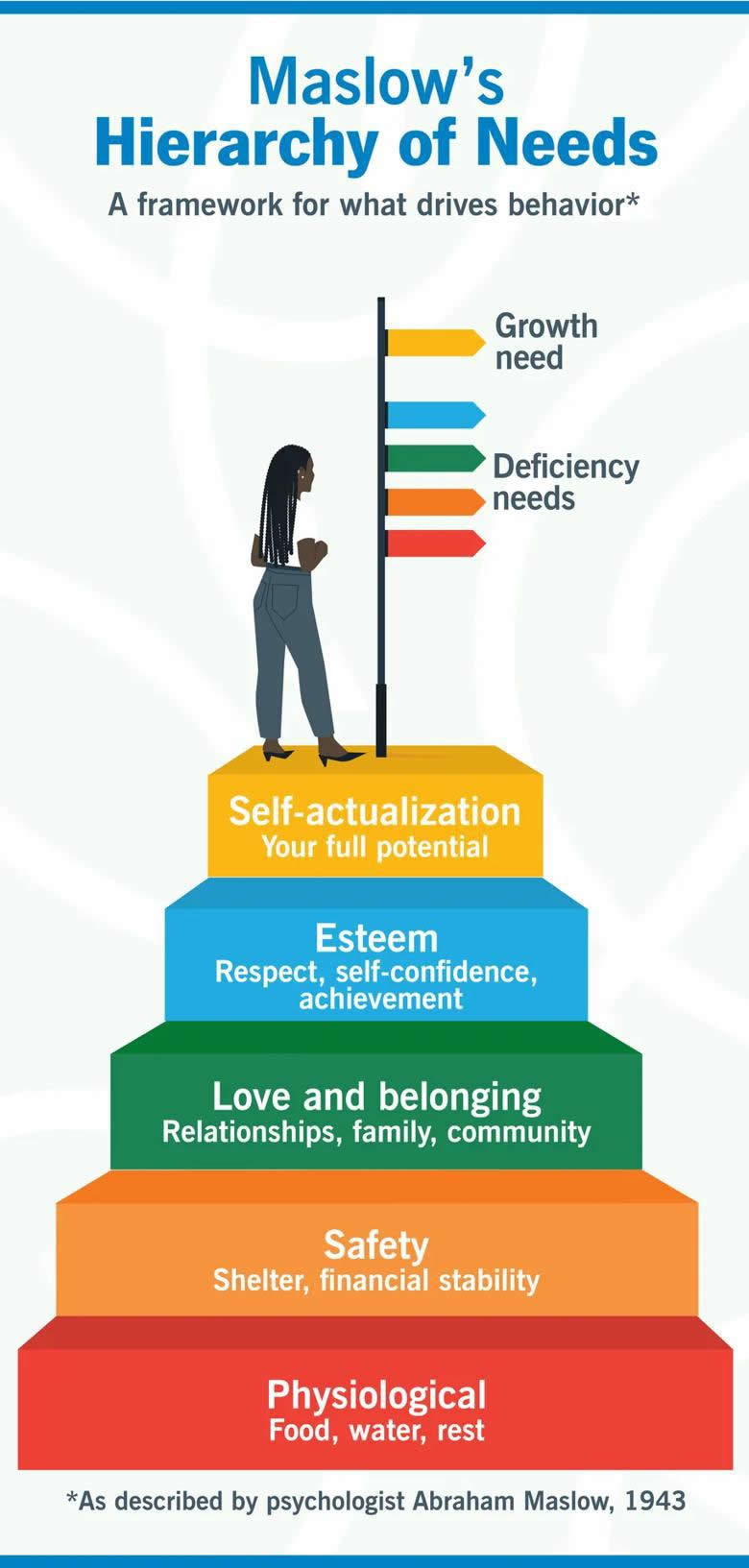What Motivates You? Understanding Maslow’s Hierarchy of Needs
This theory of human motivation says people seek to meet their needs in a predictable order

If you’ve ever taken an intro to psychology class, the words “Maslow’s Hierarchy of Needs” might ring a bell. (Or maybe the bell was a Pavlov thing?)
What is it that Maslow was talking about? And can it help explain why we do the things we do?
Clinical psychologist Dawn Potter, PsyD, explains.
What is Maslow’s Hierarchy of Needs?

Maslow’s Hierarchy of Needs is a theory of human motivation created by psychologist Abraham Maslow in the 1940s. It outlines what we need to become our best selves.
“It’s a framework that describes what motivates people and when,” Dr. Potter says. “It explains that we have needs and that we typically seek to meet them in a certain order.”
Order is a big thing in the hierarchy of needs. That’s why you’ll usually see it represented as a pyramid.
How the pyramid works
Maslow’s original Hierarchy of Needs had five levels. In the strictest interpretation, each level in the pyramid has to be met to successfully pursue the next. The order goes like this:
- Physiological
- Safety
- Love and belonging
- Esteem
- Self-actualization
Maslow’s theory says that only after your physical (physiological) needs, like food and water, are met can you then set your sights on your next-level need for safety. And if your physical needs are met and you’re safe and secure, you then address your need to develop close relationships with others. And so on, up to the top of the pyramid.
The first four steps are sometimes called “deficiency needs.” They’re the ones that are outside of yourself. The top of the pyramid, self-actualization, is called a growth need. It’s about the drive that comes from within you and compels you to be your fullest self.
“Say I’m counseling a high school student, and I want to encourage them to consider college. But they need to contribute financially to keep their family from losing their home. Their need for esteem or self-development probably isn’t going to be on their radar because what they really need, in that moment, is the safety of financial security,” Dr. Potter illustrates.
In many interpretations of the hierarchy, people can skip steps. But trying to leapfrog the order can often lead to stress or friction.
“Trying to skip a step or trying to do things out of order potentially causes hardship,” she adds.
What’s more, you can fall back to a lower level on the pyramid if things change.
“It’s not like, I went grocery shopping today, so now I don’t have to worry about my basic needs ever again,” Dr. Potter notes. “You can need different things at different times.”
One day, you can be gunning for a promotion, but troubles brew in your relationships, so you can drop down a peg until those needs are attended to.
Let’s take a closer look at each level.
1. Physiological
The bottom rung on the pyramid contains our basic necessities. That includes things like:
- Food
- Water
- Air
- Rest
- Sufficient health
If your plane crashes on a deserted island, these are the problems you’re probably going to try to solve first. If you’re injured and dehydrated, chances are, you’re not going to prioritize making small talk and building friendships with the other survivors — unless they have bandages and water to share with you.
2. Safety
Our need for security is a survival instinct that has helped keep humans alive for countless generations. Maslow’s safety needs include:
- Physical security, like stable housing
- Emotional freedom, like not feeling fearful
- Financial stability and job security
- Environmental safety, like freedom from war and a safety net of protective services
Going back to the plane crash, what are you going to do after you’ve received first aid and found something to eat and drink? Maslow’s Hierarchy of Needs says you’ll find somewhere safe to sleep. You might also team up with other survivors to take shifts during the night so someone can alert the group to predators and other threats.
3. Love and belonging
The third level of Maslow’s Hierarchy of Needs is the need for love and belonging. People are social creatures. Our need to connect with one another is important to our well-being. At this step, we’ll pursue needs like:
- Romantic relationships
- Family relationships
- Friendships
- A sense of community
This is the time on that deserted island when you start to form bonds with other survivors. You might trade life stories, share resources and agree to certain rules.
4. Esteem
Esteem refers to our need to feel respected, capable and appreciated. It can compel us to:
- Set goals and work diligently to meet them
- Seek validation and recognition from others
- Work on our self-confidence
- Pursue education and self-development
- Try new hobbies
As they reach step four on the hierarchy, the plane crash survivors have met most of their everyday needs, so they start to look for a sense of purpose.
They might develop their fishing skills and feel accomplished when they’re acknowledged for their contributions to the greater group. Others may look to take on leadership roles, like organizing expeditions of the island.
5. Self-actualization
Self-actualization is Maslow’s envisioned peak. It’s the point where our needs from the outside world are fulfilled and our drive turns inward. Few people actually achieve self-actualization.
“Self-actualization means reaching your full potential,” Dr. Potter explains. “It’s a rare state where you’re doing what you truly want, motivated only by your desires and not by what’s needed or expected of you.”
If you were to become self-actualized on the island, it could look like being at peace with the idea that you might never be rescued. You’d have all you need right where you are and want for nothing.
Expanded model
Over the years, Maslow built upon his original model to add three more layers.
To go along with Esteem, he added:
- 4.1:Cognitive needs: Feeling intellectually stimulated and challenged
- 4.2:Aesthetic needs: Appreciating beauty and art
And after Self-actualization, he added:
- 6:Transcendence needs: Looking beyond yourself — through spirituality or service to others
Like self-actualization, these additional steps in the pyramid are described as growth needs, rather than deficiency needs.
Criticism of Maslow’s Hierarchy of Needs
Maslow’s theory may provide some useful clues into how people tend to behave. But people don’t always act as the pyramid describes.
It’s one thing to consider how a group who lands on a remote island might prioritize their needs. It’s another thing to say for certain what people out in society will do.
Among the critiques of the pyramid are concerns like:
- Lack of evidence: Maslow’s hierarchy isn’t necessarily grounded in rigorous studies of real-world human behavior.
- Cultural differences: People can be motivated by different needs, depending on their personal and societal values.
- Rigidity: It’s possible, maybe even likely, to be motivated by more than one thing at any given time.
Even still, Maslow’s Hierarchy of Needs gives us a way to think about what drives us — from finding food and safety to seeking love, respect and purpose. While life isn’t always a perfect journey from A to Z, the framework can help us understand why we feel stuck at times or why certain goals may feel out of reach.